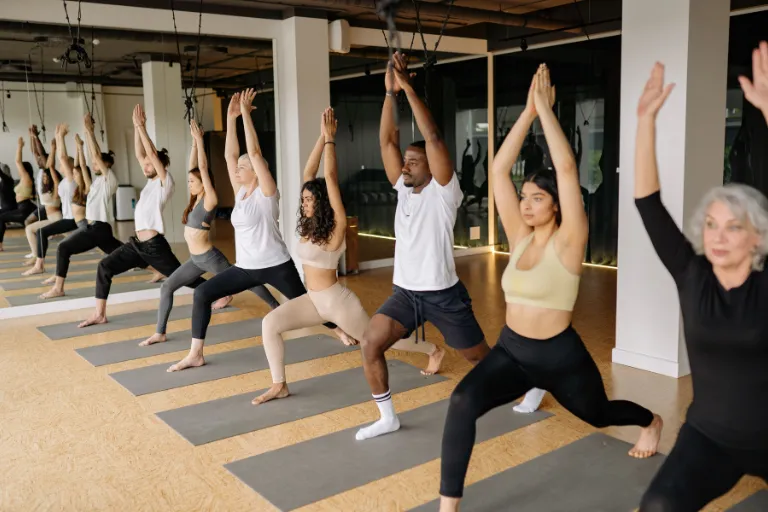Wichtige Erkenntnisse
- Wellness isn’t one-size-fits-all—every body, regardless of size, shape, or ability, deserves access to health.
- Science shows movement improves health outcomes at any weight.
- Intuitive eating and adaptive fitness support long-term well-being without shame or restriction.
- New tools like a CE-marked non-invasive vagal neuromodulation system are opening doors for those managing chronic symptoms.
“The goal isn’t to change your body. It’s to care for the one you have—right now.”
Why the Old Fitness Model Doesn’t Work for Everyone
Most gyms still advertise with the same image: lean, young, and sweaty. But real bodies? They’re fat, thin, trans, disabled, tired, strong, soft, and everything in between.
And here’s the kicker: fitness culture still tells millions of people they don’t belong.
- 84% of gym-goers in larger bodies report being stared at or judged during workouts¹.
- Many disabled or neurodivergent people can’t even access fitness spaces due to poor design or stigma³.
- And let’s not forget gendered locker rooms and binary-focused trainers that leave nonbinary folks in the cold⁴.
The consequences aren’t just emotional. They’re physiological: people move less, internalize shame, and experience rising rates of chronic tiredness, stress, and disordered eating⁷.
What Actually Makes You Healthy? (Hint: It’s Not Weight)
Forget BMI. Modern research shows it’s fitness, not fatness, that drives long-term health:
“A higher-weight person who is physically active has lower mortality risk than a thin, sedentary person.”
— Progress in Cardiovascular Diseases, 2018²
Here’s what movement really does:
- Boosts heart rate variability
- Lowers inflammation
- Improves mood and energy
- Supports blood sugar regulation⁶
And it works across the spectrum. Whether you’re lifting 2 lbs from a chair or dancing in your living room, movement benefits every body.
Adaptive Fitness = Fitness That Fits You
Want to move more but not sure where to start? Try these inclusive workout formats:
- Chair yoga – Great for people with joint pain or limited mobility
- Water aerobics – Reduces impact on knees and spine
- Virtual low-impact dance – Energy-boosting and non-intimidating
- Sensory-friendly gym hours – Lower lights, less noise, fewer crowds
“We don’t need to push bodies to the brink. We need to teach people to move with joy and self-respect.”
— Leslie P., inclusive trainer, New York City
Intuitive Eating > Diet Culture
Tired of rigid rules and “clean eating” guilt? So are the experts. Inclusive nutrition now favors:
- Intuitive eating – Eat when you’re hungry, stop when you’re full
- Mindful meals – Enjoy what you eat without obsessing
- Cultural diversity – Foods that honor your background and taste, not someone else’s fad
This approach has been linked to:
- Lower risk of disordered eating
- Improved body image
- Better long-term metabolic markers⁷
Stress, Recovery & the Vagus Nerve
Sometimes, stress or chronic symptoms make even gentle workouts feel overwhelming. That’s where a new tool enters the chat:
Vagal Neuromodulation like Nurosym, delivered via a CE-marked wearable ear clip, helps calm the body’s stress signals without meds.
This non-invasive device stimulates the vagus nerve (your body’s regulatory superhighway). Clinical studies show it can:
- Improve energy in people with chronic tiredness
- Reduce anxious thoughts and help stabilize heart rhythms
- Support recovery after post-viral fatigue episodes⁸
With 0 serious adverse events in over 50 studies to date⁹, it’s gaining attention as an adaptive wellness solution.
Meet Emily: A Real Comeback Story
Emily, 30, loved hiking—until a post-viral illness left her dizzy, exhausted, and sidelined. Even light exercise triggered heart racing and crashes. Doctors linked it to postural heart rate abnormalities.
Her solution? Inclusive wellness.
- She began with short, adaptive walks
- Ate intuitively, not restrictively
- Used a CE-marked vagal neuromodulation system nightly
“It helped calm my body enough to enjoy movement again,” she says.
Today, Emily hikes weekly and does tai chi on Zoom—with a community that looks like her.
Start Building Your Routine—Your Way
Want to make your wellness journey inclusive?
Here’s your starter list:
- Set function-based goals (not weight-loss ones): “sleep better,” “carry groceries with ease,” “feel less stressed”
- Try adaptive workouts that meet your mobility and energy levels
- Support mental health with body-neutral affirmations
- Seek out size-inclusive health professionals
- Consider tools like vagal nerve stimulation to aid recovery and resilience
“The best wellness plan is the one that makes you feel like you belong in your body.”
Referenzen
- OriGym. Weight Stigma in Fitness Environments, 2023.
- Barry, V.W. et al. Obesity and Fitness: Mortality Risk, Prog Cardiovasc Dis, 2018.
- Johns Hopkins. Health at Every Size Evidence Summary, 2020.
- Kuper, L.E. et al. Transgender and Nonbinary Access to Fitness Spaces, Transgender Health, 2021.
- Wells, J.C.K. The Myth of Somatotypes, Am J Hum Biol, 2020.
- Swift, D.L. et al. Exercise and Insulin Sensitivity, Curr Sports Med Rep, 2012.
- Van Dyke, N. et al. Intuitive Eating and Mental Health, Eat Behav, 2013.
- Bonaz, B. et al. Vagus Nerve and Mind-Body Regulation, Nat Rev Gastroenterol Hepatol, 2016.
- Parasym™. Vagal Neuromodulation Safety Summary, 2024.
Der Artikel stellt in keiner Weise eine medizinische Beratung dar. Bitte konsultieren Sie einen zugelassenen Arzt, bevor Sie eine Behandlung beginnen. Diese Website kann Provisionen für die in diesem Artikel erwähnten Links oder Produkte erhalten.



